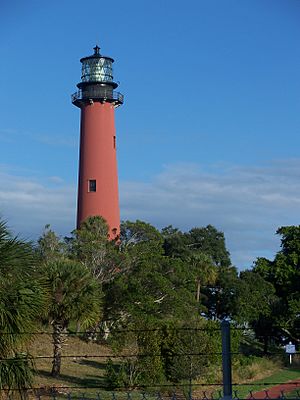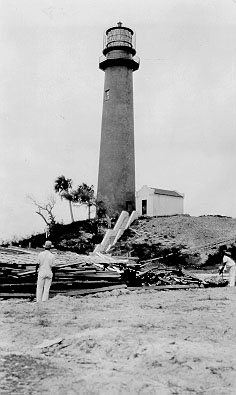Jupiter Inlet Light facts for kids
| Location | North side of the Jupiter Inlet in Jupiter, Florida |
|---|---|
| Coordinates | 26°56′55″N 80°04′55″W / 26.94861°N 80.08204°W |
| Year first constructed | 1860 |
| Year first lit | 1860 |
| Automated | 1928 |
| Foundation | Concrete |
| Construction | Brick |
| Tower shape | Conical tower/cylindrical tower |
| Height | Tower: 105 feet (32 m), above water: 153 feet (47 m) |
| Original lens | First order Fresnel lens |
| Range | 25 nautical miles (46 km; 29 mi) |
| Characteristic | Fixed white varied by two white flashes every 30 seconds |
The Jupiter Inlet Light is a famous lighthouse located in Jupiter, Florida. You can find it on the north side of the Jupiter Inlet. This important landmark stands between the Cape Canaveral Light and the Hillsboro Inlet Light.
The spot for the lighthouse was chosen way back in 1853. It was designed by Lieutenant George G. Meade, and later improved by Lieutenant William Raynolds. Building the lighthouse was tricky because the Jupiter Inlet got blocked with sand in 1854. This meant all building materials had to be brought in by small boats down the Indian River. Work even stopped for a few years, from 1856 to 1858, because of a conflict called the Third Seminole War. Finally, the lighthouse was finished in 1860 by Captain Edward A. Yorke.
The lighthouse was built on a natural sand dune, which some people once thought was an ancient Indian shell mound. The tower itself is 105-foot (32 m) tall. Its light shines 153 feet (47 m) above sea level, making it visible from 24 nautical miles (44 km; 28 mi) out at sea. The lighthouse is made of brick with two strong walls. It was painted red in 1910 to hide stains from the humid weather. In 2004, Hurricane Jeanne blasted off some of the paint, so the tower was repainted with a special mineral coating.
Contents
History of the Lighthouse
Early Days and Design
For thousands of years, the land where the Indian River meets the Jupiter Inlet was a special meeting place for ancient Indian tribes. In 1849, U.S. Army surveyors noticed this important spot. They suggested it would be a good place for military defenses. In 1854, President Franklin Pierce officially set aside about 61 acres of land for the lighthouse.
Lieutenant George Gordon Meade first designed the lighthouse. Later, Lieutenant William Raynolds made the design even stronger by adding a double wall. Captain Edward Yorke oversaw the building of the lighthouse and its oil house. He arrived in December 1859 and finished the tower in May 1860. The light was first turned on July 10, 1860.
Adding New Technologies
In 1889, a Weather Bureau station and a signal station were added to the lighthouse grounds. Ships passing by were given signals using flags during the day and flares at night. A Naval wireless telegraph station was set up there in 1890. It was later discovered in 1925 that the lighthouse property was actually larger than first thought, covering over 113 acres. By 1930, it grew to nearly 122 acres, including the tower, a keeper's house, a radio beacon, and other buildings. In 1917, the lighthouse was temporarily managed by the Navy during the first world war.
The U.S. Navy took over some of the land and, by 1936, was running a Radio Compass Station at Jupiter. This station helped ships navigate, broadcast weather, and listened for distress signals. On July 1, 1939, all U.S. lighthouses became the responsibility of the U.S. Coast Guard. That same year, the Navy set up a secret listening post at the Naval Radio Station. They also built barracks for naval personnel and their families.
By July 1940, the Navy's secret "Station J" was active. This hidden base was designed to listen in on German U-boat radio messages. It helped warn Allied ships and allowed U.S. forces to find and attack enemy submarines. Station J was very successful at finding the names and locations of these submarines. In May 1943, 30 German submarines were destroyed, and in June, another 37. Most of these were found thanks to the work of the people at Station J.
Jupiter Inlet Lighthouse and Museum
On January 11, 1972, the Loxahatchee River Historical Society (LRHS) was created to protect the area's history. They opened the Oil House Museum in June 1973. People could take tours of the lighthouse with permission from the U.S. Coast Guard. On November 15, 1973, the Lighthouse was added to the National Register of Historic Places. By 1988, the Society had opened the Florida History Center and Museum in Burt Reynolds Park.
In 1994, the LRHS made an agreement with the Coast Guard to take care of the Jupiter Inlet Lighthouse. For the first time, they started offering regular public tours to the top of the lighthouse. The LRHS also ran a small visitor center in a building that was once living quarters for the military at Station J.
In 1999, the LRHS began a big project to fix weather damage to the tower. They received a grant from the Florida Department of Transportation and worked with the Town of Jupiter and the U.S. Coast Guard. This important restoration was completed in April 2000.
In 2006, the old World War II building in Lighthouse Park was renovated. This was thanks to an agreement between the LRHS, Palm Beach County, and the Town of Jupiter. On December 7, 2006, the history museum and the society's main office moved to Lighthouse Park. It became known as the Jupiter Inlet Lighthouse and Museum. The LRHS also signed a 30-year lease with the U.S. Coast Guard. This allowed them to manage a larger part of the land around the tower. They set up outdoor history exhibits there. Now, all lighthouse and museum operations are in one place.
Today, the Loxahatchee River Historical Society runs the Jupiter Inlet Lighthouse and Museum. The museum is located in Lighthouse Park, at 500 Captain Armour's Way, Jupiter, Florida. You can check their official website for current hours. Visitors can climb the lighthouse tower and explore the History Museum. You just need to register for admission through the gift shop.
Jupiter Inlet Lighthouse Outstanding Natural Area
The Jupiter Inlet Lighthouse Outstanding Natural Area (JILONA) Act was a special law. Senator Bill Nelson and Senator Mel Martinez introduced it in the Senate. In the United States House of Representatives, Congressman Tim Mahoney introduced it. Congressmen Ron Klein and Alcee Hastings also supported it. This law made the lighthouse and 120 acres of important natural land around it an Outstanding Natural Area (ONA). It is part of the Department of the Interior's Bureau of Land Management's (BLM) National Landscape Conservation System.
The JILONA site is the first Outstanding Natural Area (ONA) in the eastern United States. Two other ONAs on the Pacific Coast also protect lighthouses: Yaquina Head in Oregon and Piedras Blancas Lighthouse in California. President George W. Bush signed the law on May 8, 2008. This protects the Jupiter Inlet Lighthouse site for everyone forever.
The JILONA is managed by several groups working together. These include the Bureau of Land Management and local partners like Palm Beach County, the Town of Jupiter, the Village of Tequesta, the Loxahatchee River Historical Society, the U.S. Coast Guard, and Jupiter High School's Environmental Research and Field Studies Academy. Over the past ten years, this group has completed many projects. They have restored the lighthouse, rebuilt wetlands, and stabilized the river slope after hurricanes Frances and Jeanne. They have also reduced fire hazards and improved habitats for endangered species. This shows that the Jupiter Inlet Working Group is a very successful partnership. In April 2008, the group received the special Cooperative Conservation Award from the Department of the Interior. This award recognized their hard work in protecting the Jupiter Inlet's natural beauty and history.



